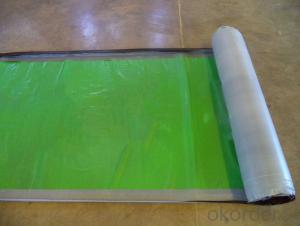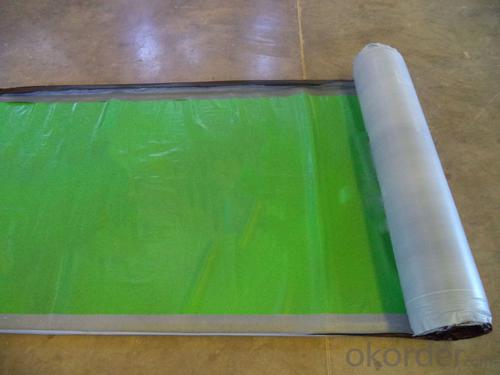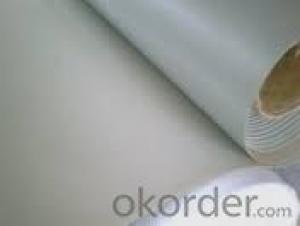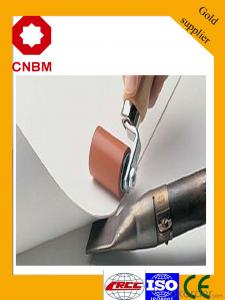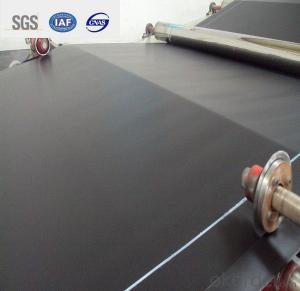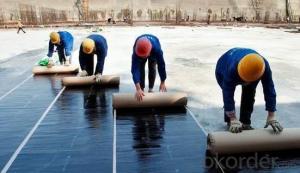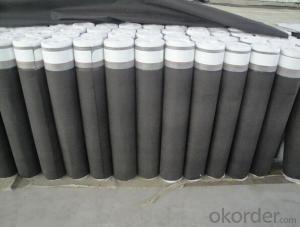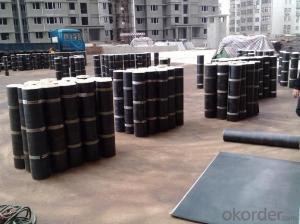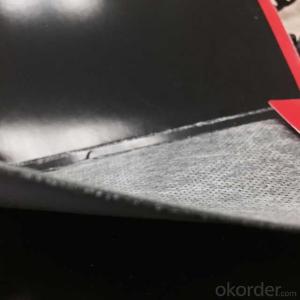Self adhesive bitumen waterproof membrane
- Loading Port:
- Qingdao
- Payment Terms:
- TT OR LC
- Min Order Qty:
- 500 m²
- Supply Capability:
- 1000000 m²/month
OKorder Service Pledge
OKorder Financial Service
You Might Also Like
1. Introduction
Self-adhesive bitumen waterproof membrane is composed of base material, including synthetic
rubber like SBS, good road asphalt and viscosity increaser. The surface is covered by PE film,
aluminum foil film, EVA, HDPE, and the silicon depositing release film is covered on the lower
surface as anti-sticking layer.
2. Specification
1) Thick: 1.2mm, 1.5mm, 2.0mm, 3.0mm, 4.0mm
2) Size: 1m (width)*10m (length) or customized
3) Type: With or without polyester felt
4) Surface: PE film, aluminum foil film, EVA/HDPE, Double-side adhesive PE film
5) Certificate: ISO9001/14001
3. Applications
1) Widely used in the industrial and civil building roofing, underground, pool, tunnel,
wooden and metal roofing.
2) Specially applied in the chemical factory, garment factory, and granary.
3) Especially used in cold places.
4) Tape used for sealing all construction material surfaces.
4. Features
1) Cold-applied construction with no open flame and self-adhesion without bonding agent
make it safe, low- carbon, environmental, and economical.
2) Excellent adhesive performance guarantees the integrity of waterproof layer.
3) Good rubber elasticity, elongation and shear stress
4) Good low-temperature property
- Q: What type of maintenance is required for a waterproofing membrane?
- Regular maintenance is required for a waterproofing membrane to ensure its effectiveness and longevity. This maintenance typically includes inspecting the membrane for any signs of damage, such as cracks or tears, and promptly repairing them. Additionally, it is important to keep the membrane clean and free from debris to prevent clogging or blockages. Regular inspections and maintenance will help to extend the life of the waterproofing membrane and ensure it continues to effectively protect the underlying structure.
- Q: Is a waterproofing membrane resistant to impact damage?
- The main purpose of a waterproofing membrane is not to withstand impact damage. Rather, it is primarily intended to safeguard the underlying structure from moisture damage and prevent water infiltration. Although certain membranes may possess a certain degree of impact resistance, it is not their principal attribute. In order to shield the membrane from impact damage, additional precautions such as incorporating protective layers or utilizing materials that are resistant to impact may be required.
- Q: Can a waterproofing membrane be installed underneath tile or other flooring materials?
- Yes, a waterproofing membrane can be installed underneath tile or other flooring materials to protect against moisture and water damage.
- Q: Can a waterproofing membrane be used on below-grade foundations?
- Yes, a waterproofing membrane can be used on below-grade foundations. In fact, it is recommended to use a waterproofing membrane on below-grade foundations to prevent water infiltration and protect the foundation from moisture damage. The membrane acts as a barrier, effectively preventing water from seeping into the foundation walls and causing issues such as leaks, mold, and structural damage. Additionally, waterproofing membranes are designed to withstand the high water pressure typically found in below-grade environments, making them an ideal solution for protecting foundations in basements and other below-ground structures.
- Q: Can waterproofing membranes be used on swimming pool decks?
- Yes, waterproofing membranes can be used on swimming pool decks. Waterproofing membranes are designed to create a barrier against water penetration, making them an ideal solution for areas that are constantly exposed to water, such as swimming pool decks. By applying a waterproofing membrane to the deck surface, it helps to prevent any water from seeping through and causing damage to the underlying structure. Additionally, waterproofing membranes can also provide protection against chemicals, UV rays, and general wear and tear, which are common in swimming pool environments. Overall, using waterproofing membranes on swimming pool decks can help extend their lifespan, reduce maintenance costs, and enhance the overall safety and appearance of the area.
- Q: Can a waterproofing membrane be used in interior or exterior applications?
- A waterproofing membrane can be utilized in both interior and exterior scenarios. When used indoors, such as in basements or bathrooms, the membrane can be applied to walls or floors to effectively prevent water or moisture infiltration. This safeguard shields the underlying structure from potential harm caused by water intrusion. For exterior applications, the waterproofing membrane can be employed on the outer walls or foundations of a building to effectively repel water. This becomes particularly crucial in regions with heavy rainfall or high water tables. By creating a barrier against water, the membrane effectively maintains a dry and water-free interior environment for the building. In conclusion, the utilization of a waterproofing membrane in both interior and exterior contexts is absolutely necessary in order to ensure the longevity and durability of a structure by effectively safeguarding it against water-related issues.
- Q: Is a waterproofing membrane compatible with different types of flooring materials?
- Yes, a waterproofing membrane is compatible with different types of flooring materials. It can be used with various flooring options like tiles, hardwood, laminate, vinyl, and more to provide protection against water damage and ensure a long-lasting and durable flooring installation.
- Q: What is the accounting subject of the waterproofing membrane
- following two subjects repair costs. For the use of materials used in construction, included in the construction in progress
- Q: Can a waterproofing membrane be used in laundry rooms?
- Indeed, the utilization of a waterproofing membrane is viable in laundry rooms. These spaces are frequently subjected to water and humidity due to the presence of washing machines, sinks, and various water-related activities. The installation of a waterproofing membrane within the laundry room serves to avert any water harm that may affect the walls, floors, and other essential components. It functions as a barrier that obstructs water infiltration, guaranteeing that any accumulated water or moisture within the room does not permeate the underlying surfaces. This proves particularly advantageous for laundry rooms situated on higher levels or in regions prone to excessive humidity or flooding. By employing a waterproofing membrane, homeowners can safeguard their laundry rooms against potential issues associated with water, such as the growth of mold, deterioration, or structural impairment.
- Q: Can a waterproofing membrane be used in stadiums or sports complexes?
- Yes, a waterproofing membrane can be used in stadiums or sports complexes to protect the structural elements from water damage and prevent leaks.
Send your message to us
Self adhesive bitumen waterproof membrane
- Loading Port:
- Qingdao
- Payment Terms:
- TT OR LC
- Min Order Qty:
- 500 m²
- Supply Capability:
- 1000000 m²/month
OKorder Service Pledge
OKorder Financial Service
Similar products
Hot products
Hot Searches
Related keywords
